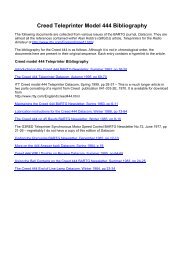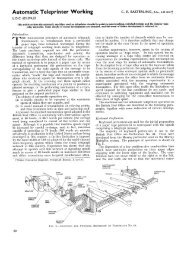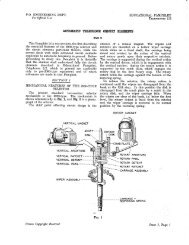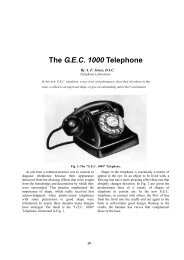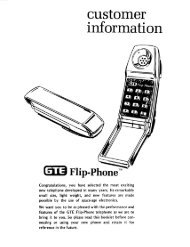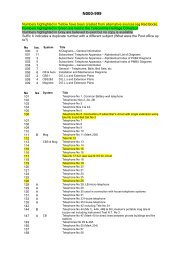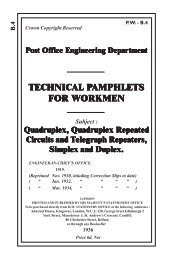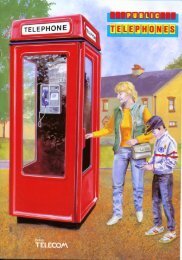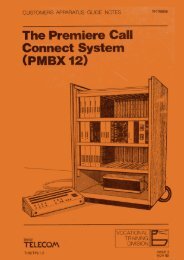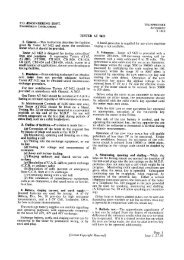TRAFFIC CONTROL TELEPHONE SYSTEMS Circuit - Sam Hallas
TRAFFIC CONTROL TELEPHONE SYSTEMS Circuit - Sam Hallas
TRAFFIC CONTROL TELEPHONE SYSTEMS Circuit - Sam Hallas
You also want an ePaper? Increase the reach of your titles
YUMPU automatically turns print PDFs into web optimized ePapers that Google loves.
here that from SC bank contacts 29 to 39, Relay IS is held by direct positive battery<br />
connections to these bank contacts. SC bank contacts 41, 43 and 45 are also connected<br />
direct to positive, whilst SC bank contacts 40, 42 and 44 are connected to<br />
positive via TS2.<br />
It will be remembered that line switch SC stepped under the control of Relay<br />
SD. When it has stepped to SC bank contact 49, Relay LC will be released at SC<br />
wipers 3/4. LC4 releases Relay BR, which at BR2 and BR4 disconnects the impulsing<br />
circuit and removes the battery from the lines. LC3 completes the driving circuit for<br />
stepping the line switches SA and SB to normal from 50 volt negative through the<br />
operating magnets, self drive contacts, wiper arms SA1 and SBI, G4, LC3, to 50 volt<br />
positive. When the wiper arms reach the normal position, these driving circuits are<br />
broken.<br />
Line switch SC continues to drive under the control of Relay SD (until it<br />
reaches its home position) from 50 volt negative, SC driving magnet SD, wiper arms<br />
SC 1/2. At the home position, Relay SD releases since there is no 50 volt positive<br />
through LC2.<br />
At the conclusion of the conversation the Controller restores his speak key<br />
which releases relays BC, BCA and the circuit is ready for further calls.<br />
In order to avoid false operation of relay TC (when BC releases) due to the<br />
charging of the line capacity, the auxiliary relay BCA is introduced which follows BC<br />
but is slow to release. After the release of BC and during the release time of BCA<br />
(approximately ¼ second) the line is charged to the normal voltage and polarity over<br />
contacts BCA 2 and 3, and resistor YR. When BCA finally releases the resistor YR is<br />
replaced by the windings of the relay TC but by this time the charging current to the<br />
line will have ceased or dropped to such a small value that it cannot give a false<br />
operation of TC relay.<br />
It should be noted that at the instant when BC releases the line may be completely<br />
discharged (as it would be at the end of a long call) or it may be holding a<br />
charge which has been imparted by the signalling battery (as it would be if the call is<br />
released immediately after signalling). In either of these cases the device described<br />
will safeguard the TC relay from false operation.<br />
General Call<br />
No dialling is necessary with a "general call." A "general call" is given by sending<br />
out one continuous train of 17 impulses, thereby operating all telephone selectors to<br />
the ringing position past all code pins. To make a "general call," the Controller<br />
operates the <strong>Circuit</strong> Key to the "Speak" position, and then the "General Call" Key.<br />
This latter key operates Relay GCA via 50 volt positive, "General Call" key, "Speak"<br />
key, Terminal LR, Relay GCA to 50 volt negative, and also Relay GC via 50 volt<br />
positive. "General Call" key, "Speak" key, Terminal GC, Relay GC to 50 volt negative.<br />
Relay GC locks over its second winding via 50 volt negative, Relay GC, GC1,<br />
Line switch SC bank 3 and 4 to 50 volt positive. A circuit to operate Relay LC is set<br />
up via 50 volt negative, Relay LC, GC7, line switch SC banks 3/4, to 50 volt positive.<br />
Page 45



